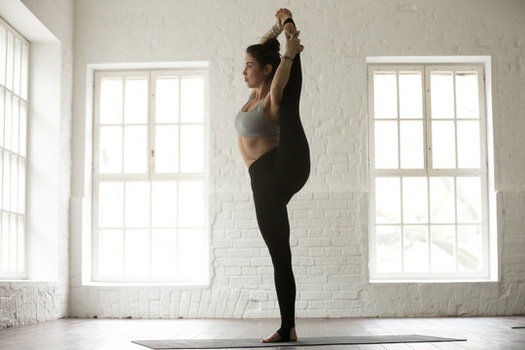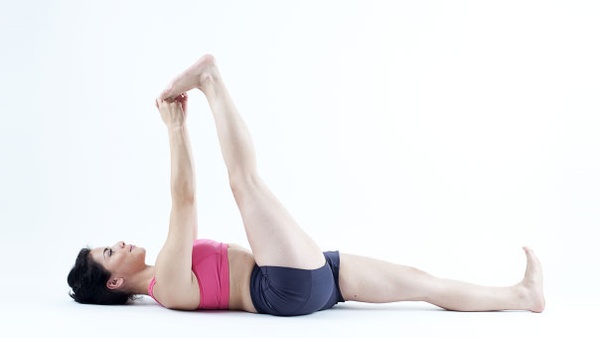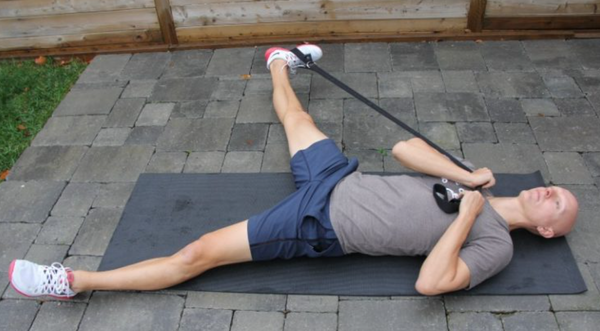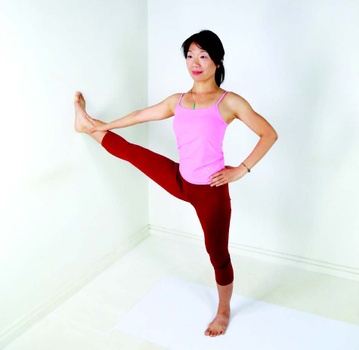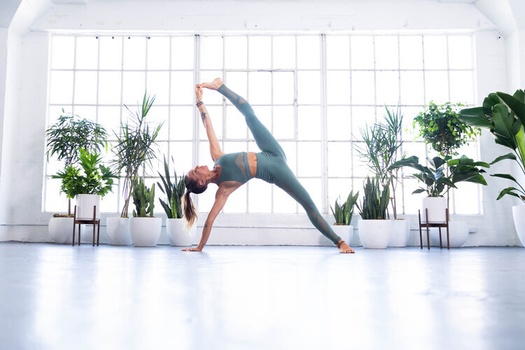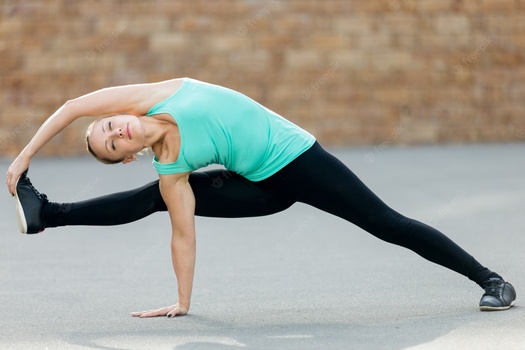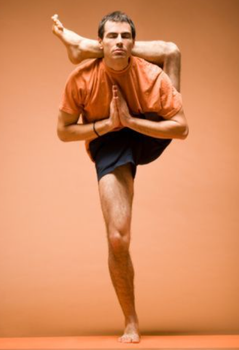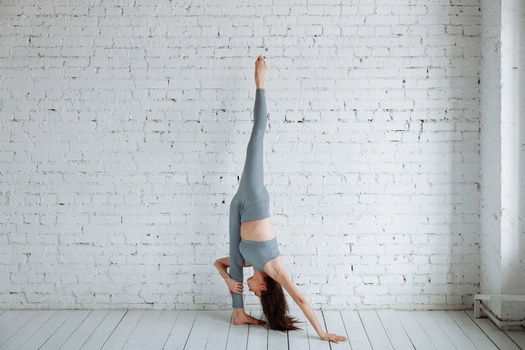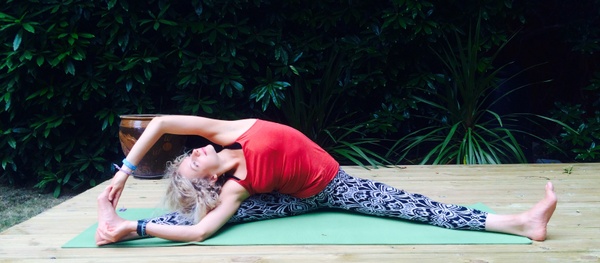This pose is divided into structured phases so that all levels of yogis can get started. Let’s jump right in!
Part 1 - Preparatory Poses for Trivikramasana
For Trivikramasana, all you need is strong legs, a stable core, and a flexible pelvis. Here are some postures to help you get ready for the main pose:
1. Vrikshasana (Tree Pose) - Stand straight, bring your right foot against your left thigh, and place your hands against your chest in Anjali Mudra. Take a few deep breaths and then extend your arms overhead, keeping your palms formation intact and hold this pose here.
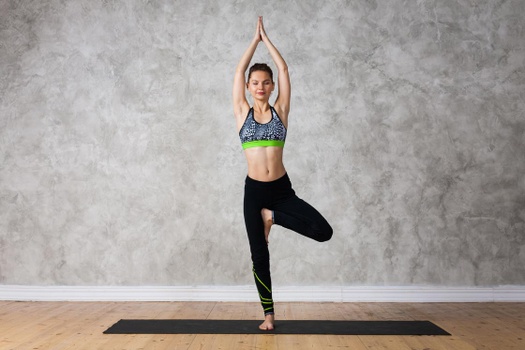
Perform this for 3 to 5 minutes regularly, and it will help you develop improved balance on a single leg and condition your core for the main practice.
2. Anantasana (Sleeping Vishnu Pose) - Lie down on your side and rest your head over your palm. Inhale and lift your leg straight toward the floor. Hold your big toe with your fingers, and slowly start to pull your straight leg sideways, getting it closer to your head.
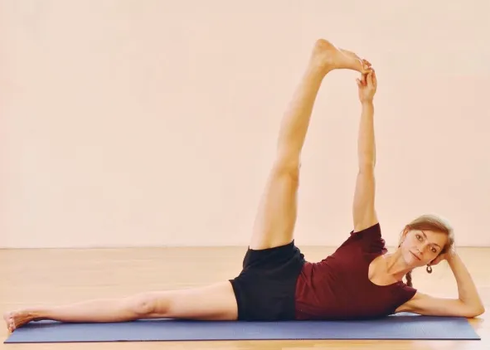
Hold this pose here for one minute, exhale and bring your lifted leg down on the mat. Repeat the same on the other side and do this for 3 to 5 minutes.
This helps to strengthen your obliques and shoulders, plus unlocks your tight glutes, inner thighs, hamstrings, and hip flexors all at once.
Part 2: Step-by-Step Instructions to Perform Trivikramasana
The following are steps to practice the Three Steps pose or Standing Split pose:
Step 1- Stand straight in Mountain pose and focus on your breath for a minute.
Step 2- Stack two to three yoga blocks on your right side, and rest your right foot on these yoga blocks to open your groin area.
Step 3- Bring your right leg close to your chest, keep your left leg straight, and hug your right leg with both arms wrapped around it.
Step 4- Focus on your breath and hold your right heel with your right hand and right toes with your left hand, and lengthen your right leg straight to the ceiling.
Step 5- Stretch your leg as much as possible. Ideally, the goal is to stretch it straight up, making a 180-degree angle with one leg in the air and the other on the mat.
Step 6- Repeat the same on the left side and release the pose by returning to Tadasana.
Breath Awareness:
Inhale: In Mountain position, while hugging your bent leg close to the chest.
Inhale & Exhale: While stretching up and getting into the Standing Split.
Exhale: Once the Standing Split is over and your leg is back on the floor.
Performance Duration for Beginners: Hold Trivikramasana for 15 to 30 seconds on each side.
Performance Duration for Advanced: Hold Trivikramasana for 30-90 seconds on each side
Part 3: Things to Keep in Mind
One minor mistake can lead you to severe injuries while performing the Three Steps pose. Here are a few things things to keep in mind:
Engage your core: Your abdomen, glutes, thighs, and low back area together to form your core. If this area is not actively engaged while standing in Trivikramasana, it’s highly likely you won’t be able to balance your body on one leg and you may also stumble.
Keep your spine neutral: If you’re slouching forward or overextending your neck backward in Trivikramasana, you won’t be able to balance your body on one leg. Fixing your gaze in front and standing up straight is necessary. Your straight spine will also urge your lifted leg to lengthen in the same direction a bit easier, and help you appropriately target the right muscle groups.
Focus on your breathing: Breath awareness is something you realize by being mindful of each inhale/exhale action accompanied by the movement of a specific body part. Maintaining an excellent focus on your breath will also make this challenging Standing Split easy to get into and hold for a long duration.
Part 4: Relaxing Poses After Trivikramasana
Once you’ve gotten through your Trivikramasana practice, you’ll be ready to relax with the following yoga pose sequence.
1. Prasarita Padottanasana (Wide-Legged Standing Forward Bend) - This pose aids in calming post-stretch tension around your spine, neck, shoulders, and hamstrings. Start in Mountain pose, then spread your right leg to the right side. Inhale and grab your waist with your hands. Exhale and fold forward, keeping your legs straight.
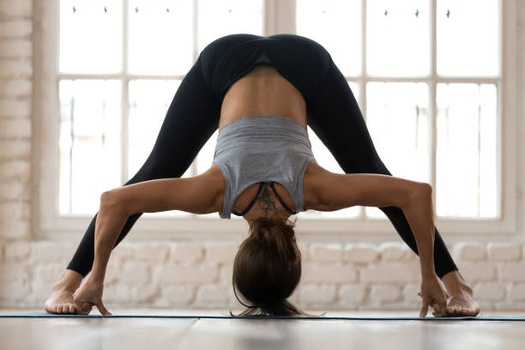
Place your hands flat on the floor, inhale more, and gaze up in front. Exhale again and bring your head down even more so that the crown of your head touches the mat. Breathe here 5-6 times and finally release by coming up.
2. Ananda Balasana (Happy Baby Pose) - Lie flat on your back, inhale and lift up your legs, bringing both knees close to your chest. Now, stretch your arms on the inside of your legs and hold your big toes using the toe lock of your fingers.

Now, gently open your hips, and widen your legs to deepen the stretch. Make sure your head is resting on the floor, and that each ankle is stacked directly over your knee so that your shins look perpendicular to the ground. Hold this pose here to entirely relax your pelvis, spine, and neck.
